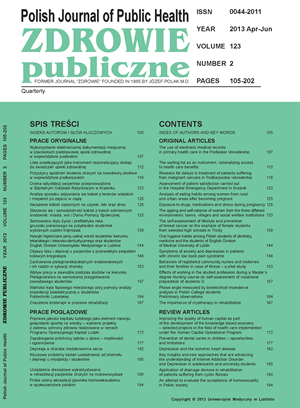Analysis of eating habits among women from rural and urban areas after becoming pregnant
DOI:
https://doi.org/10.12923/j.0044-2011/123-2/a.05Keywords:
habit, women, pregnancyAbstract
Introduction. Improper eating habits among pregnant women may have a negative impact on fetal development and pregnancy. Balanced diet during pregnancy period should provide women with the right amount of energy as well as contain essential nutrients in the correct quantities and ratios.
Aim. Evaluation of nutritional habits among pregnant women.
Material and methods. The study was conducted among 100 pregnant women aged 21-38 years from urban and rural areas from different neighborhoods of Świdnik. Information on diet was obtained based on questionnaire survey.
Results. Inadequate intake of fish and high intake of sweets was reported. Fruit and vegetables intake was found to be at satisfactory level. Habit of eating fast food products among expectant mothers remains as worrying issue.
Conclusions. Among examined group of expectant mothers, incorrect eating habits such as getting on food between meals and insufficient consumption of fish was reported. It is important to carry out activities in the field of health education in perinatal care that promotes healthy eating.
References
1. Florek E, Adamek R, Adamek AM, et al. Czynna i bierna ekspozycja kobiet ciężarnych na dym tytoniowy a stan zdrowia noworodka – świadomość zagrożeń. Now Lek. 2001:70(2):133-43.
2. Worach-Kardas H. Stan zdrowia ludności w dorosłej Polsce w świetle badań empirycznych. Mat.IV Seminarium CINDI, WHO. Łódź; 2000. p.89-97.
3. Pisarkiewicz M, Bielecki W. Wykształcenie jako determinanta zachowań zdrowotnych w populacji miejskiej. Mat. IV Seminarium CINDI, WHO. Łódź; 2000. p.62-70.
4. Chazan B. Zwiększająca się częstość urodzeń dzieci z małą urodzeniową masą ciała – nowy problem polskiej perinatologii. Perinatol Ginekol. 2003;2:7-12.
5. Kaiser L, Allen LH. Position of the American Dietetic Association: nutrition and lifestyle for a healthy pregnancy outcome. J Am Diet Assoc. 2008;108(3):553-61.
6. Kondo A, Shimosuga Y, Oguchi H, et al. Folic acid reduces the risk of neural tube defects: awarensess and folate intake among pregnant women in 2006. Hinyokika Kijo. 2008;54(8):537-42.
7. Suliga E. Zachowania żywieniowe kobiet w ciąży. Pediatr Endocrinol Diabetes Metab. 2011;17(2):76-81.
8. Rao S, Yajnik CS, Kanade A, et al. Intake of micronutrient – rich foods in rural Indian mothers is associated with the size of their babies at birth: Pune Maternal Nutrition. Study J Nutr. 2001;131:1217-24.
9. Ramon R, Ballester F, Iniguez C, et al. Vegetable but not fruit intake during pregnancy is associated with newborn anthropometric measures. J Nutr. 2009;139:561-7.
10. Mrzygłód S. Wpływ odżywiania matki na rozwój płodu. Probl Hig Epidemiol. 2007;88(4):402-7.
11. Gacek M. Niektóre zachowania zdrowotne oraz wybrane wskaźniki stanu zdrowia grupy ciężarnych kobiet. Probl Hig Epidemiol. 2010;91(1):48-53.
12. Solnica B, Mazur A. Niedokrwistość z niedoboru żelaza. Bad Diag. 2006;12:81-4.
13. Cieslik E, Gębusia A. Skutki niedostatecznej podaży kwasu foliowego ze szczególnym uwzględnieniem znaczenia dla kobiet w wieku rozrodczym. Hygeia Public Health. 2011;46(4):431-6.
14. Perenc M. Wady ośrodkowego układu nerwowego – etiologia, diagnostyka prenatalna i profilaktyka. Przew Lek. 2002;4:51-4.
15. Wawrzyniak A, Hamułka J, Kosowska B. Ocena spożycia energii, tłuszczu i cholesterolu u kobiet w ciąży. Żyw Człow Metab. 2003;1/2:520-5.


